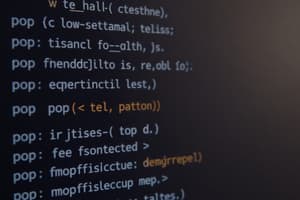Podcast
Questions and Answers
What does the dir() function do in Python?
What does the dir() function do in Python?
Returns a list of the attributes and methods of any object.
Which methods are returned for a list when using dir()?
Which methods are returned for a list when using dir()?
append, clear, copy, count, extend, index, insert, pop, remove, reverse, sort
Which methods are returned for a tuple when using dir()?
Which methods are returned for a tuple when using dir()?
count, index
Which methods are returned for a dictionary when using dir()?
Which methods are returned for a dictionary when using dir()?
Which methods are returned for a set when using dir()?
Which methods are returned for a set when using dir()?
What is the purpose of the append() method in Python?
What is the purpose of the append() method in Python?
What does the clear() method do in Python?
What does the clear() method do in Python?
What is the function of the copy() method in Python?
What is the function of the copy() method in Python?
How does the count() method work in Python?
How does the count() method work in Python?
What does the extend() method do in Python?
What does the extend() method do in Python?
What is the purpose of the index() method in Python?
What is the purpose of the index() method in Python?
Study Notes
dir() Function in Python
- The
dir()function lists attributes and methods of any object in Python3. - Syntax:
dir({object})where {object} is optional. - Helps in understanding available methods for data structures such as Lists, Tuples, Dictionaries, and Sets.
Methods for Lists
- Created using
l = []orl = list(). - Common methods:
append(): Adds an element at the end.clear(): Removes all elements.copy(): Creates a shallow copy.count(): Counts occurrences of a value.extend(): Combines another list.index(): Finds the index of the first occurrence.insert(): Adds an element at a specified index.pop(): Removes an element at a specified index or the last element.remove(): Deletes the first occurrence of a value.reverse(): Reverses the list.sort(): Sorts the list.
Methods for Tuples
- Created using
t = ()ort = tuple(). - Common methods:
count(): Counts occurrences of a value.index(): Finds the index of the first occurrence.
Methods for Dictionaries
- Created using
d = {}ord = dict(). - Common methods:
clear(): Removes all key-value pairs.copy(): Creates a shallow copy.fromkeys(): Creates a new dictionary from keys.get(): Retrieves a value for a given key.items(): Returns a view of key-value pairs.keys(): Returns a view of keys.pop(): Removes a specified key and returns its value.popitem(): Removes and returns the last key-value pair.setdefault(): Returns the value of a key, or sets it.update(): Updates dictionary with key-value pairs from another dictionary.values(): Returns a view of values.
Methods for Sets
- Created using
s = set(). - Common methods:
add(): Adds an element.clear(): Removes all elements.copy(): Creates a shallow copy.difference(): Returns elements not in another set.discard(): Removes an element without raising an error.intersection(): Returns common elements with another set.pop(): Removes and returns an arbitrary element.remove(): Removes a specified element.union(): Combines two sets.
Exercises Summary
- Append: Program to continuously add integers to a list until 'done' is entered.
- Clear: Program demonstrating the
clear()method to empty a list. - Copy: Highlights how changes to the original list don't affect the copied list.
- Count: Program that counts occurrences of a user-provided character in a list.
- Extend: Combines two user-input integer lists into one using
extend(). - Index: Demonstrates finding the index of a string in a list, with error handling for a missing string.
Studying That Suits You
Use AI to generate personalized quizzes and flashcards to suit your learning preferences.
Related Documents
Description
This quiz focuses on the practical exercise of using the dir() function in Python 3 to explore the attributes and methods of Lists, Tuples, Dictionaries, and Sets. It provides an understanding of the syntax and parameters of the dir() function, aiding in object-oriented programming in Python.




